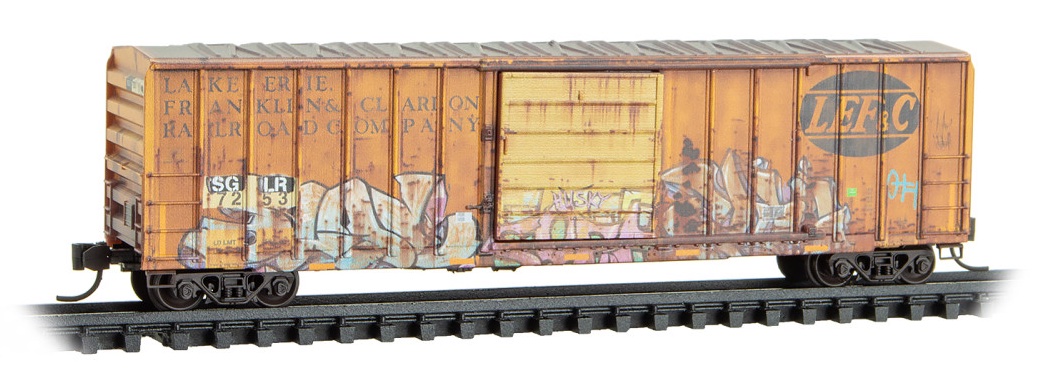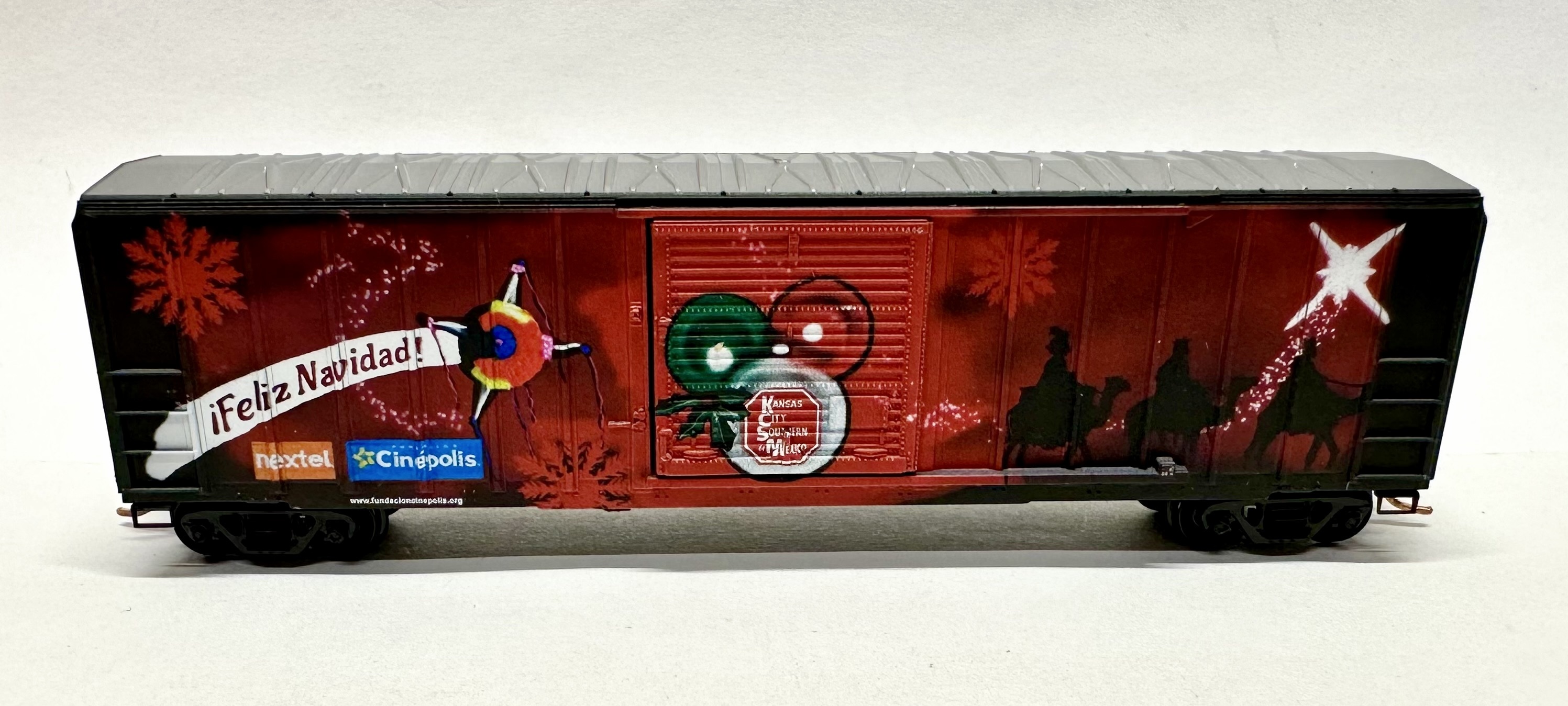Specific Item Information: Built by Evans in 1979 for the Lake Erie, Franklin & Clarion Railroad Company, this 50’ boxcar was used in the Incentive Per Diem program. To encourage the return of the boxcars, short line railroads, like Port Huron, could charge a per diem, or daily fee, until the cars were returned. Eventually, the car, in original paint, made its way to the Seminole Gulf Railway. Founded in 1987, the Seminole Gulf is a short line freight and passenger excursion railroad operating out of Fort Myers, Florida.
Series Information: Series launched in April of 2024.
Model Information: This model was first produced by Kadee in February of 1981. It is a model of a 50 Foot Steel Rib-Side Single Sliding Door Boxcar. Specifically, this Micro-Trains body style models the FMC 50' 5077 Single Sliding Door prototype. It is also used by Micro-Trains to model Pullman Standard 50' boxcars. Hence on some releases, this car is labeled as a Pullman Standard and in other cases it is labeled as an FMC boxcar, and it also is frequently labeled as a '50' Rib Side Box Car[sic]' with no mention of prototype whatsoever. It appears to be closest to the FMC 5077 boxcar prototype (from the 1970s) in any event. These models can appear with any one of multiple different sliding door types. The doors for this model are operating ones (cool!).
Prototype History: In the 1970's with the growth of the Per Diem business model, FMC produced a series of 50 foot box cars in different configurations. The single-sliding-door configuration is one of the best known and used widely by many different railroads. These cars were produced using the Gunderson metal works which FMC had acquired in 1965. In late 1975, FMC began producing a 5,077-cubic-foot Plate B box car for IPD and Railbox service. FMC's 5077s have seven panels to either side of the 10-foot door, an X-panel roof, and non-terminating ends that are slightly different from those used on FMC's earlier cars. Note how the sidesill is notched all the way back to the bolsters, a key feature of FMC's mature design.
The main difference between the 5077 cu. ft cars built by FMC vs the 5277-5347 cu. ft cars built by the same manufacturers is the overall height of the car, the smaller 5077 cars were Plate B while the larger 5277-5347 cars were Plate C. Over 4,300 cars were produced from 1975-1979 by FMC's Portland, Oregon plant. The cars were delivered in numerous colorful shortline paint schemes, as well as the nationwide car pool fleet of Railbox. Many secondhand cars were later seen in Class 1 railroads and large leasing company fleets under additional shortline reporting marks.
The main difference between the 5077 cu. ft cars built by FMC vs the 5277-5347 cu. ft cars built by the same manufacturers is the overall height of the car, the smaller 5077 cars were Plate B while the larger 5277-5347 cars were Plate C. Over 4,300 cars were produced from 1975-1979 by FMC's Portland, Oregon plant. The cars were delivered in numerous colorful shortline paint schemes, as well as the nationwide car pool fleet of Railbox. Many secondhand cars were later seen in Class 1 railroads and large leasing company fleets under additional shortline reporting marks.
Road Name History:  The SGLR launched in 1987 as a spinoff from Seaboard System. There are two disconnected routes. The larger runs from Arcadia to the North Naples area. The smaller runs from Oneco south to Venice with branches to Sarasota, Matoka, and Fruitville, all in the southwestern portion of Florida. A branch to Venice was abandoned in segments between 2004 and 2019. Total mileage is 118, putting it between RF&P and Chicago & Illinois Midland in relative size. The lines originally belonged to Atlantic Coast Line and Seaboard Air Line. In the early days, Seminole Gulf ran with seven GP9’s and a GP10. SGLR also picked up a C425 but later sold it to an Alco-heavy shortline in New York. Recently they picked up a trio of B39-8E’s for heavy freight service.
The SGLR launched in 1987 as a spinoff from Seaboard System. There are two disconnected routes. The larger runs from Arcadia to the North Naples area. The smaller runs from Oneco south to Venice with branches to Sarasota, Matoka, and Fruitville, all in the southwestern portion of Florida. A branch to Venice was abandoned in segments between 2004 and 2019. Total mileage is 118, putting it between RF&P and Chicago & Illinois Midland in relative size. The lines originally belonged to Atlantic Coast Line and Seaboard Air Line. In the early days, Seminole Gulf ran with seven GP9’s and a GP10. SGLR also picked up a C425 but later sold it to an Alco-heavy shortline in New York. Recently they picked up a trio of B39-8E’s for heavy freight service.
Since 1991, SGLR has run passenger excursion service with a recent focus on murder mystery dinner trains. SGLR picked up an F9Am and F7Am to lead the excursion trains. These are in the same blue with yellow and orange paint scheme used on freight units. Freight traffic includes limestone, forest products and wallboard, newsprint, and LPG. Seminole Gulf has a sister railroad, the Bay Colony Railroad in Massachusetts.

Since 1991, SGLR has run passenger excursion service with a recent focus on murder mystery dinner trains. SGLR picked up an F9Am and F7Am to lead the excursion trains. These are in the same blue with yellow and orange paint scheme used on freight units. Freight traffic includes limestone, forest products and wallboard, newsprint, and LPG. Seminole Gulf has a sister railroad, the Bay Colony Railroad in Massachusetts.
Brand/Importer Information: Micro-Trains is the brand name used by both Kadee Quality Products and Micro-Trains Line. For a history of the relationship between the brand and the two companies, please consult our Micro-Trains Collector's Guide.
Manufacturer Information:  Micro-Trains Line split off from Kadee Quality Products in 1990. Kadee Quality Products originally got involved in N-Scale by producing a scaled-down version of their successful HO Magne-Matic knuckle coupler system. This coupler was superior to the ubiquitous 'Rapido' style coupler due to two primary factors: superior realistic appearance and the ability to automatically uncouple when stopped over a magnet embedded in a section of track. The success of these couplers in N-Scale quickly translated to the production of trucks, wheels and in 1972 a release of ready-to-run box cars.
Micro-Trains Line split off from Kadee Quality Products in 1990. Kadee Quality Products originally got involved in N-Scale by producing a scaled-down version of their successful HO Magne-Matic knuckle coupler system. This coupler was superior to the ubiquitous 'Rapido' style coupler due to two primary factors: superior realistic appearance and the ability to automatically uncouple when stopped over a magnet embedded in a section of track. The success of these couplers in N-Scale quickly translated to the production of trucks, wheels and in 1972 a release of ready-to-run box cars.
Micro-Trains Line Co. split off from Kadee in 1990 to form a completely independent company. For this reason, products from this company can appear with labels from both enterprises. Due to the nature of production idiosyncrasies and various random factors, the rolling stock from Micro-Trains can have all sorts of interesting variations in both their packaging as well as the products themselves. When acquiring an MTL product it is very important to understand these important production variations that can greatly enhance (or decrease) the value of your purchase.
Please consult our Micro-Trains Collector's Guide

Micro-Trains Line Co. split off from Kadee in 1990 to form a completely independent company. For this reason, products from this company can appear with labels from both enterprises. Due to the nature of production idiosyncrasies and various random factors, the rolling stock from Micro-Trains can have all sorts of interesting variations in both their packaging as well as the products themselves. When acquiring an MTL product it is very important to understand these important production variations that can greatly enhance (or decrease) the value of your purchase.
Please consult our Micro-Trains Collector's Guide
Item created by: CNW400 on 2024-11-30 16:40:53. Last edited by grothe77 on 2024-12-03 12:58:22
If you see errors or missing data in this entry, please feel free to log in and edit it. Anyone with a Gmail account can log in instantly.
If you see errors or missing data in this entry, please feel free to log in and edit it. Anyone with a Gmail account can log in instantly.










